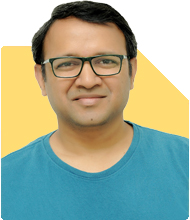Ramalingam Kalirajan |10899 Answers |Ask -Follow
Mutual Funds, Financial Planning Expert - Answered on Jun 30, 2024
He has an MBA in finance from the University of Madras and is a certified financial planner.
He is the director and chief financial planner at Holistic Investment, a Chennai-based firm that offers financial planning and wealth management advice.... more

Hi Sir, Iam 26 years old unmarried,having salary of 1.2Lacs per month already started with term life insurance of mine with 1cr, NPS contribution of 4500/month,PPF of 5k per month,with health insurance of self and parents also being covered. However I want to start SIP for investment reasons and for my future planning. Please suggest me how much of percentage should go to mutual funds.
Understanding Your Financial Position
You’re earning Rs 1.2 lakhs per month, which is a strong starting point. With a term life insurance of Rs 1 crore, an NPS contribution of Rs 4,500 per month, a PPF of Rs 5,000 per month, and health insurance for yourself and your parents, you’ve laid a solid foundation. Let’s now focus on SIPs in mutual funds to further secure your future.
Determining Savings Allocation
Since you’re young and have time on your side, it’s wise to invest a higher percentage in equity funds, which have the potential for higher returns over the long term. Considering your age, a 70-30 split (70% in equity and 30% in debt) is recommended for your mutual fund investments.
Benefits of SIP in Mutual Funds
SIP (Systematic Investment Plan) allows you to invest a fixed amount regularly, irrespective of market conditions. This helps in averaging out the cost of purchase over time and benefits from the power of compounding.
Equity Mutual Funds
Equity funds invest in stocks and have the potential to offer high returns. Here’s why they should form the major part of your portfolio:
High Growth Potential: Over the long term, equity funds can significantly outperform other types of investments.
Diversification: These funds invest in a variety of companies across sectors, reducing risk.
Liquidity: They offer easy entry and exit, unlike some other investment options.
Given your age, allocate 70% of your mutual fund investment to equity funds.
Debt Mutual Funds
Debt funds invest in fixed-income securities like bonds and treasury bills. They are safer but provide lower returns compared to equity funds. Here’s why they’re important:
Stability: They provide a cushion against market volatility.
Regular Income: They offer regular returns, which can be useful for meeting short-term financial goals.
Liquidity: Debt funds are more liquid than fixed deposits and other traditional savings instruments.
Allocate the remaining 30% of your mutual fund investment to debt funds.
How Much to Invest?
To determine how much to invest, consider your disposable income. After accounting for all your essential expenses and existing investments (NPS, PPF), decide on an amount you can comfortably invest monthly.
Diversifying Within Equity Funds
Equity mutual funds can be further categorized into large-cap, mid-cap, and small-cap funds. Here's a suggested allocation:
Large-Cap Funds: These funds invest in well-established companies with a strong track record. They offer stable returns with lower risk. Allocate about 50% of your equity investment here.
Mid-Cap Funds: These funds invest in medium-sized companies with high growth potential. They carry moderate risk and can offer higher returns than large-cap funds. Allocate about 30% of your equity investment here.
Small-Cap Funds: These funds invest in smaller companies. They are high-risk but can offer very high returns. Allocate about 20% of your equity investment here.
Selecting Debt Funds
For debt funds, consider a mix of short-term and long-term debt funds:
Short-Term Debt Funds: These are suitable for meeting your short-term goals and provide liquidity. Allocate 60% of your debt investment here.
Long-Term Debt Funds: These are more stable and offer better returns over the long term. Allocate 40% of your debt investment here.
Monitoring Your Investments
Regularly monitor your investments to ensure they align with your financial goals. It's essential to review your portfolio at least once a year and make adjustments based on market conditions and changes in your financial situation.
Tax Implications
Keep in mind the tax implications of your investments. Long-term capital gains (LTCG) on equity funds are taxed at 10% for gains exceeding Rs 1 lakh. Short-term capital gains (STCG) are taxed at 15%. For Hybrid debt funds, LTCG is taxed at 20% with indexation benefits, and STCG is added to your income and taxed as per your tax slab.
You're already doing a fantastic job by starting your financial planning early. Your disciplined approach to saving and investing will pay off in the long run. Keep up the good work!
We understand that navigating investments can be overwhelming, but remember, every step you take towards securing your financial future is a step in the right direction. It's okay to seek help when needed, and we're here to support you.
Long-Term Planning
Consider your long-term financial goals, such as buying a home, traveling, or starting a family. Align your investments to these goals to ensure you have the funds when you need them.
Working with a Certified Financial Planner
A Certified Financial Planner can provide personalized advice tailored to your financial situation and goals. They can help you optimize your investment strategy and ensure you're on track to meet your objectives.
Final Insights
Investing in mutual funds through SIPs is a smart and disciplined approach to building wealth over time. By allocating 70% of your savings to equity funds and 30% to debt funds, you can strike a balance between growth and stability. Regularly monitor and adjust your investments to stay aligned with your financial goals. You're on the right path, and with continued diligence and planning, you'll achieve your financial dreams.
Best Regards,
K. Ramalingam, MBA, CFP,
Chief Financial Planner,
www.holisticinvestment.in
You may like to see similar questions and answers below
Omkeshwar Singh | Answer |Ask -Follow
Head, Rank MF - Answered on Jun 03, 2022
Ulhas Joshi |280 Answers |Ask -Follow
Mutual Fund Expert - Answered on Mar 30, 2023
Jinal Mehta | Answer |Ask -Follow
Financial Planner - Answered on Mar 08, 2024
Vivek Lala |323 Answers |Ask -Follow
Tax, MF Expert - Answered on Jun 20, 2024
Ramalingam Kalirajan |10899 Answers |Ask -Follow
Mutual Funds, Financial Planning Expert - Answered on Dec 17, 2025
Ramalingam Kalirajan |10899 Answers |Ask -Follow
Mutual Funds, Financial Planning Expert - Answered on Dec 17, 2025
Ramalingam Kalirajan |10899 Answers |Ask -Follow
Mutual Funds, Financial Planning Expert - Answered on Dec 17, 2025
Ramalingam Kalirajan |10899 Answers |Ask -Follow
Mutual Funds, Financial Planning Expert - Answered on Dec 17, 2025
Ramalingam Kalirajan |10899 Answers |Ask -Follow
Mutual Funds, Financial Planning Expert - Answered on Dec 17, 2025
Mayank Chandel |2576 Answers |Ask -Follow
IIT-JEE, NEET-UG, SAT, CLAT, CA, CS Exam Expert - Answered on Dec 17, 2025
Radheshyam Zanwar |6747 Answers |Ask -Follow
MHT-CET, IIT-JEE, NEET-UG Expert - Answered on Dec 16, 2025
Shalini Singh |181 Answers |Ask -Follow
Dating Coach - Answered on Dec 16, 2025
Patrick Dsouza |1429 Answers |Ask -Follow
CAT, XAT, CMAT, CET Expert - Answered on Dec 16, 2025
Nayagam P P |10858 Answers |Ask -Follow
Career Counsellor - Answered on Dec 16, 2025





























